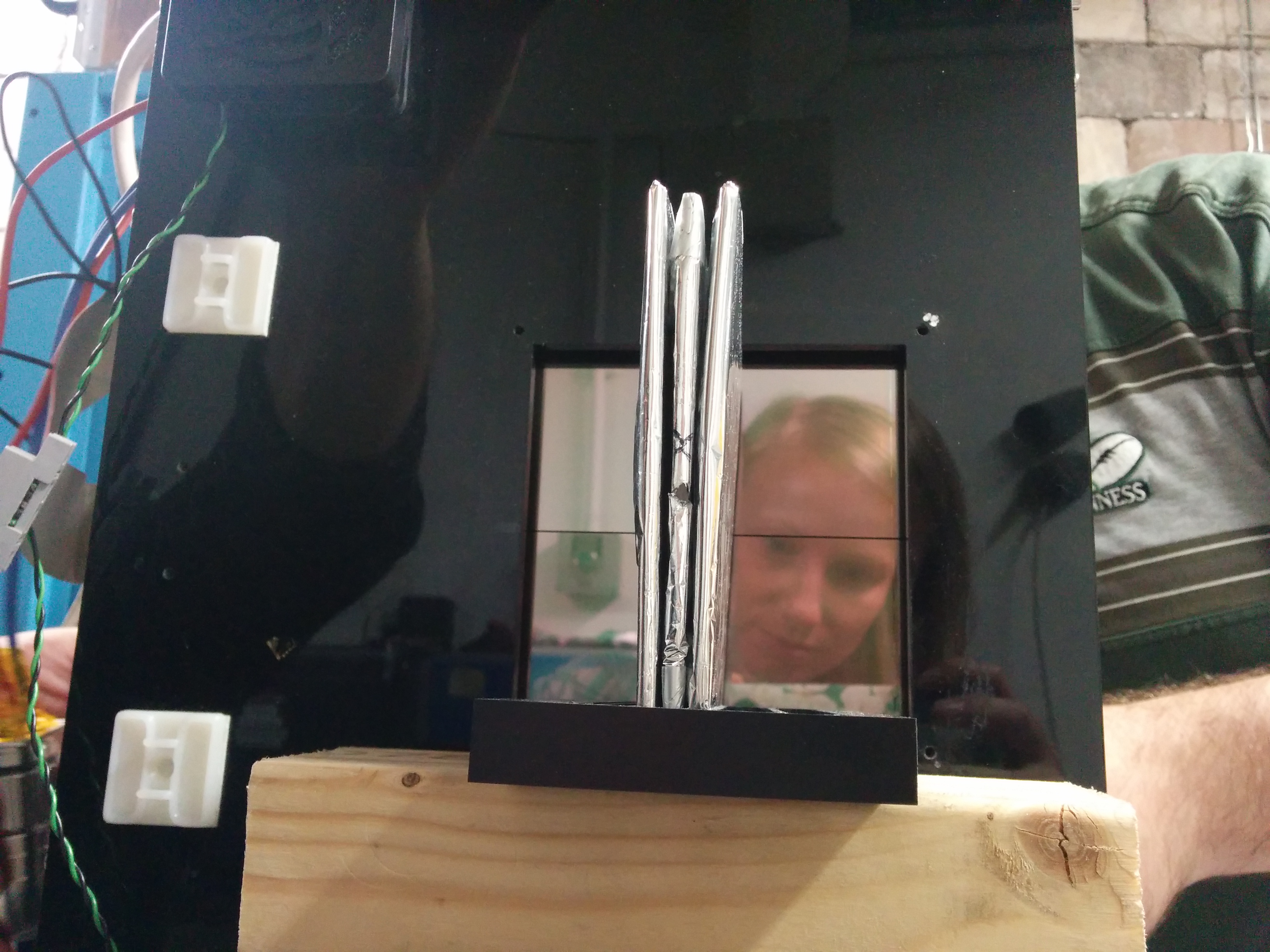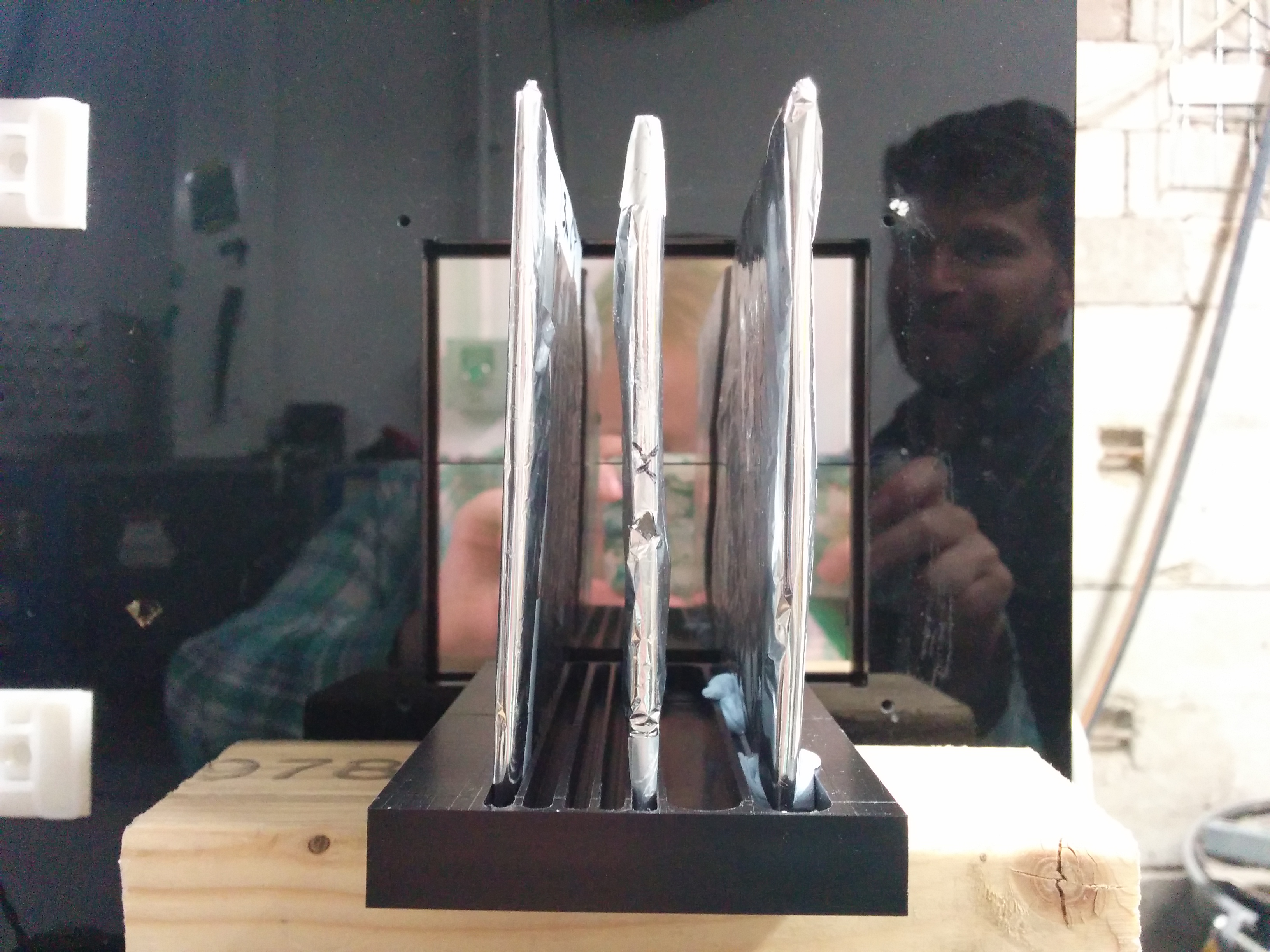Proton Calorimetry/Experimental Runs/2017/September7: Difference between revisions
No edit summary |
No edit summary |
||
| Line 34: | Line 34: | ||
*Saturation of sensor, ADC values at 14,000 | *Saturation of sensor, ADC values at 14,000 | ||
*Tiles are grouped together in a tight formation (until mentioned otherwise) | *Tiles are grouped together in a tight formation (until mentioned otherwise) | ||
<div class="image400px" style="text-align: center;"> | |||
[http://www.hep.ucl.ac.uk/pbt/wikiData/images/Birmingham_sept2017/tight_scintillators.jpg http://www.hep.ucl.ac.uk/pbt/wikiData/images/Birmingham_sept2017/tight_scintillators.jpg] | |||
<br /> | |||
</div> | |||
|| 28MeV_3mmscint_ABC_1nA_1cmC | || 28MeV_3mmscint_ABC_1nA_1cmC | ||
|- | |- | ||
| Line 48: | Line 52: | ||
*Due to gap between the sensor and the scintillators there is an overlap in the light collected by the sensor and no separation of the scintillators can be seen | *Due to gap between the sensor and the scintillators there is an overlap in the light collected by the sensor and no separation of the scintillators can be seen | ||
*In order to see some separation, place the scintillators with a gap of ~ 1-2 cm between each sheet | *In order to see some separation, place the scintillators with a gap of ~ 1-2 cm between each sheet | ||
<div class=" | <div class="image400px" style="text-align: center;"> | ||
[http://www.hep.ucl.ac.uk/pbt/wikiData/images/Birmingham_sept2017/spread_out_scintillators.jpg http://www.hep.ucl.ac.uk/pbt/wikiData/images/Birmingham_sept2017/spread_out_scintillators.jpg] | [http://www.hep.ucl.ac.uk/pbt/wikiData/images/Birmingham_sept2017/spread_out_scintillators.jpg http://www.hep.ucl.ac.uk/pbt/wikiData/images/Birmingham_sept2017/spread_out_scintillators.jpg] | ||
<br /> | <br /> | ||
</div> | </div> | ||
|| | || | ||
Revision as of 12:11, 19 September 2017
Beam tests of the Nuvia 10 mm, 4 mm and 3 mm scintillator sheets with PRaVDA CMOS pixel sensors (PRIAPUS) at the Birmingham Cyclotron with a 28 MeV beam.
Pre-data Taking Information and Notes
- The tests were carried out with an energy of 28 MeV (32 MeV was unavailable as the cyclotron had recently been through repairs). No Bragg Peak measurement was carried out to confirm the exact beam energy due to time restrictions.
- The beam was run without a scattering foil. A 1 cm diameter uniform beam was achieved by placing a 1 cm collimator in the beam, with a beam scan onto film confirming the size. An ionisation chamber was placed upstream of the collimator to accurately monitor the current.
- The dynamic range of the CMOS sensors is 14 bits. The electron conversion value from ADC is 50 electrons per ADC value. The measurements to establish this were carried out at the beginning of experimentation with the sensors and this value may have changed due to radiation damage etc.
- From previous measurements, the average background value per pixel is ~ 700.
- The data was recorded at 45 frames/second.
- The working directory on the PRIAPUS computer where the data is stored is:
idMateData\Bham070917\
- The directory the data is stored at UCL in is:
/unix/pbt/data/birmingham/sept_2017
Data Taking
| Type of run | Current | Scintillator sheets used | Scintillator arrangement | Notes | File name |
|---|---|---|---|---|---|
| Background | N/A | 3 x 3 mm | ABC |
|
Background_1 |
| Beam | 1 nA | 3 x 3 mm | ABC |
|
28MeV_3mmscint_ABC_1nA_1cmC |
| Beam | 0.1 nA | 3 x 3 mm | ABC |
|
28MeV_3mmscint_ABC_100pA_1cmC_1 |
| Beam | 0.1 nA | 3 x 3 mm | ABC | Saturation of sensor | 28MeV_3mmscint_ABC_100pA_1cmC_2 |
| Beam | 10 pA | 3 x 3 mm | ABC | Sensor no longer saturated, but no separation due to formation of tiles | 28MeV_3mmscint_ABC_10pA_1cmC |
| Beam | 10 pA | 3 x 3 mm | ABC |
|

